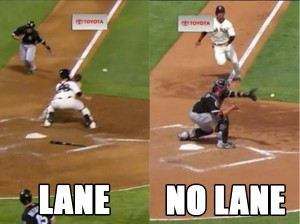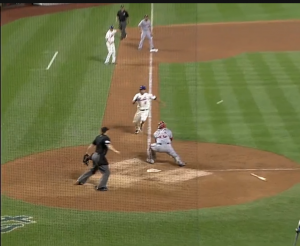I’ve heard a lot of huffing from people who aren’t Hawk Harrelson to say this:
Rule 7.13 (2) was applied correctly yesterday in San Francisco.

From the start, Tyler Flowers was in front of the plate. Watch the play. His left foot never leaves foul ground in the entire play. The momentum of the throw didn’t take him into the path of the the runner. He was always there.
The rule says:
If, in the judgment of the Umpire, the catcher without possession of the ball blocks the pathway of the runner, the Umpire shall call or signal the runner safe.
I honestly do not understand why many educated writers don’t get that part of it. Here’s one, who compares the play in San Francisco to one in Washington the same day. After a long comparison (which doesn’t include any visual aids other than Bud Selig throwing his hands up at the All-Star tie), he asks “So why was Blanco called safe?”
The bigger debate is whether there should be a rule at all.
Avila looks okay at the end of that, but he left the game and had problems the rest of that series. Which the World was watching. You know, because it was the World Series.
That latter collision caused one writer at the same website to write that there needed to be a new rule. And he wrote: “This is what the new rule should be: Home plate is the same as any other base. The catcher is the same as any other fielder. The runner must slide. The catcher cannot block the plate. The runner cannot slam into the catcher.”
That’s the new rule, in essence, without the sliding. The rule’s full, unedited text (with my own emphasis added, to express the points of the rule):
1. A runner attempting to score may not deviate from his direct pathway to the plate in order to initiate contact with the catcher (or other player covering home plate). If, in the judgment of the Umpire, a runner attempting to score initiates contact with the catcher (or other player covering home plate) in such a manner, the Umpire shall declare the runner out (even if the player covering home plate loses possession of the ball). In such circumstances, the Umpire shall call the ball dead, and all other base runners shall return to the last base touched at the time of the collision.
2. Unless the catcher is in possession of the ball, the catcher cannot block the pathway of the runner as he is attempting to score. If, in the judgment of the Umpire, the catcher without possession of the ball blocks the pathway of the runner, the Umpire shall call or signal the runner safe. Notwithstanding the above, it shall not be considered a violation of this Rule 7.13 if the catcher blocks the pathway of the runner in order to field a throw, and the Umpire determines that the catcher could not have fielded the ball without blocking the pathway of the runner and that contact with the runner was unavoidable.
So what’s the problem?
If, in the judgment of the Umpire…
Isn’t the whole problem that caused replay to be implemented is that the “judgement” of umpires not great? That the judgement of umpires cause rules to be implemented differently at different times and places?
And this rule expressly uses the term “If, in the judgement of the Umpire” twice! (And even references it a third time) That’s the problem! Judgement calls cause inequality in rules being applied.
If only we had a clear line with which we could determine where a catcher can be and can’t be. A line that will make it obvious both in live action to the players and to fans and umpires in replay. A line that would create a right side and a wrong side. One where the catcher would be playing fair, or where he was committing a foul.
If only we had a clear, visually obvious line.
If only we had one…


Discussion ¬
You must log in to post a comment.